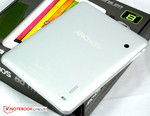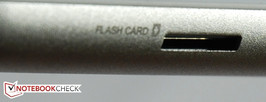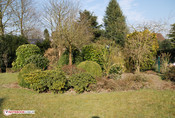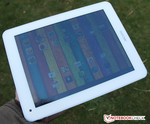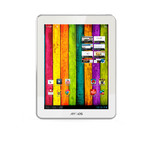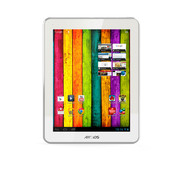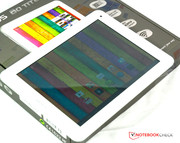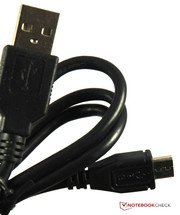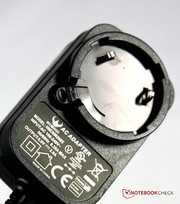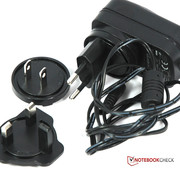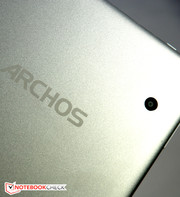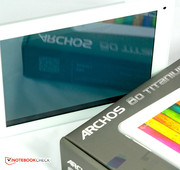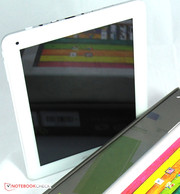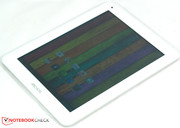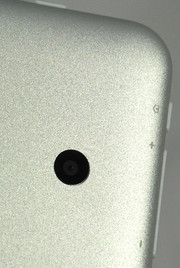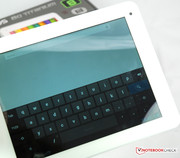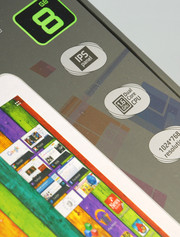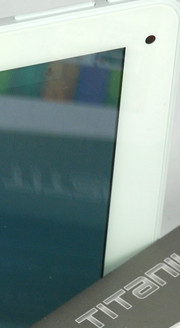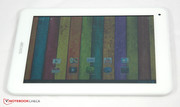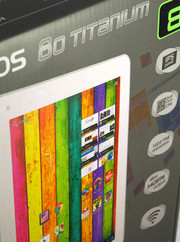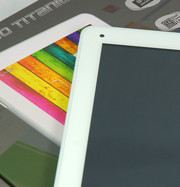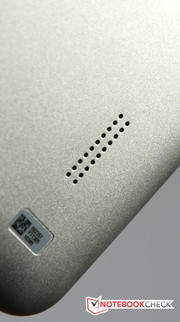As long as the ambient conditions are ideal, the IPS panel of the Archos 80 Titanium handles even very flat viewing angles very well. Colors do not distort; the display content remains readable or viewable. Things are different if the light conditions are unfavorable or the tablet is used in a bright environment. Similar to any other device with a glossy surface the panel has problems with annoying reflections that affect the viewing angle stability. The good luminance of the display tries to compensate that as well as possible. The Archos-mini is not alone with this problem, so we give the tablet a good rating for the viewing angle stability.
Review Archos 80 Titanium Tablet

For the original German review, see here.
Around 170 Euros (~$218) is the price of the Archos 80 Titanium, which looks pretty similar to the iPad Mini. However, it has a much lower price compared to the model from Cupertino that starts at 300 Euros (~$385). It is worth taking a closer look at the hardware under the aluminum surface of the 8-inch tablet from Archos. The device is equipped with a Rockchip RK3066 1.6 GHz dual core processor, 1 GB memory and a not very generous 8 GB flash storage. Graphics are handled by a Mali 400 MP4 with four cores. Android 4.1 Jelly Bean is preinstalled. In terms of equipment the device is similar to the larger Titanium-brother Archos 97 Titanium HD, which could not really convince us in our review despite the good overall rating. The display and the picture quality especially, as well as the graphics performance and reaction of the capacitive touchscreen, left room for improvement. The HD Mode was the "deal-breaker" in our review. Let's see how the 8-inch tablet without HD-functionality performs in our extensive test course.
Case
The 9.9 x 200 x 154 millimeters large case of the 8-inch tablet makes everything right on a first look - at least on the outside. At the front the protecting glass seamlessly reaches the edges, where it is surrounded by a thin white plastic frame. It is burr-free and smooth and results in a convenient feeling during handling. The white frame around the display is about 1 centimeter wide, it looks nice and is a pleasant contrast to the silver colored back of the device. The back is made of matte brushed aluminum; it has a good feeling and leaves a high quality and noble impression. It also prevents annoying fingerprints. All the ports are clearly arranged on the right side of the case.
The stability of the case is - in contrast to other Archos devices like the Archos 101 XS with a razor-thin metal back - very good. The back cover of the device enables a very high overall stability; we could not twist or bend the device at all. Thanks to the solid back cover there are also no distortions on the display; that was a problem of the Archos 101 XS. The fingertips regularly pushed through and created massive problems with the display behavior. This is no problem with the Archos 80 Titanium. Similar to its larger sibling 97 Titanium HD, the small Frenchman is a well-built Beau. Only the weight could be a bit lower: Although the device is quite small it is heavy with 440 grams. The iPad Mini is much lighter and handier in comparison with 300 grams.
Connectivity
Equipped with a Rockchip RK3066 processor with a clock of 1.6 GHz and a Mali 400MP4-GPU, the thin Frenchman also offers many ports. Next to a Micro-USB 2 port, a power connector and a Mini-HDMI port for connection with a TV, for instance, the 80 Titanium also offers a micro SD card slot for cards up to 64 GB to expand the "small" 8 GB internal storage. A 3.5 mm stereo jack for headphones is also available. For comparison: The iPad Mini is much more limited in this regard, a USB port or a micro SD card slot is not available at the Californian tablet pioneer. Another specialty of the review unit: As you can see on the pictures, the Archos device has a physical Home-Button.
Software
The Archos 80 Titanium is based on the operating system Android 4.1 Jelly Bean, which enables user-friendly and pretty smooth operation of the tablet. The device has full access to the Google Play Store and comes with some preinstalled apps like Office Suite - to read office-documents, News Republic for news from all around the globe as well as the app Brief me, which bundles Facebook, Twitter and news feeds.
Communication & GPS
The tablet is WLAN-ready (802.11 b/g/n). However, the reception is pretty weak from time to time and somewhat "inconstant". The user also has to live without data transfer via Bluetooth as well as a modem to use the internet on the road. A GPS module is also not integrated. Here Archos only offers meager standard.
Cameras & Multimedia
The picture quality of the 2 megapixel camera at the back is not overwhelming but sufficient for some snapshots. The resolution of the front facing camera is so low that the manufacturer does not even list it in the data sheet and just calls it "Webcam". As a matter of fact the resolution is just 0.3 MP, at least it serves its purpose, for example during video conferences. The quality of both cameras is a bit noisy, the contours are undefined and the overall picture is very blurry. All in all, the cameras are not very convincing.
Accessories
Next to a manual the box contains a power supply unit with three different connectors for use in other countries. They can be replaced with two steps. Otherwise there is just an USB cable. Archos offers optional accessories in its online shop, for example a stylus pen for the capacitive display for 14.99 Euros (~$19).
Warranty
In terms of warranty the manufacturer acts based on the law and offers a 24-month warranty, which is handled by the dealer.
Input Devices & Handling
The stylish Frenchman left a good impression so far, at least from the outside. But starting with the rating of the handling and a closer look at the input devices of the big brother Archos 97 Titanium HD, which was also good looking, it became evident that there were some problems with the "inner values". With the activated HD-Mode a smooth operation was hardly possible, neither browsing the Google Play Store nor relaxed web surfing were possible. All inputs were accompanied by annoying flickering and shimmering of the display.
So how does the new 8-inch device, which waives the HD-Mode completely, perform in this regard? Our determination: There is no criticism with the highly reactive and precise capacitive multitouch display with IPS technology. Inputs are recognized very precisely, typing on the virtual keyboard is smooth and precise. Even scrolling and swiping are very smooth; browsing the web with opening and closing multiple tabs is no problem for the Archos 80 Titanium either.
Display
Let us have a look at the 8-inch IPS display of the Archos 80 Titanium, which presents contents in a 4:3 ratio - the latter is similar to the 7.9-inch Apple iPad Mini. How is the brightness of the display with a resolution of 1024x768 pixels? Not bad at all, we determine a maximum brightness of 288 cd/m² and a minimum brightness of 236 cd/m² for the handy tablet from France. With these values it clearly outshines the larger Archos 97 Titanium HD. The 9.7-inch device from the Titanium series could not even reach 200 cd/m² with a maximum value of 193 cd/m².
But how does it perform compared to higher quality devices? If we consider the Californian handbag sized tablet as a reference, we quickly see that the Archos device offers good yet not overwhelming brightness values. The Apple iPad Mini has a maximum brightness of 363 cd/m²; with 100 cd/m² more it is clearly better than the French device. However, if we consider the price performance ratio, the Archos device shows solid results. After all the brighter iPad Mini is almost twice as expensive.
| |||||||||||||||||||||||||
Brightness Distribution: 82 %
Center on Battery: 288 cd/m²
Contrast: 1029:1 (Black: 0.28 cd/m²)
The good brightness values of our review unit are accompanied by a similar good black value of 0.26 cd/m². Colors are rich and the high contrast results in sharp pictures. In terms of color brilliance and contrast the display offers solid results.
The Archos 80 Titanium is also suitable for outdoor use. We do not talk about the stylish aluminum back but about the display; thanks to the good brightness it can be used outdoors. The Archos 97 Titanium HD showed problems in our review in this regard. However, the small sibling shows the content pretty reliably and the readability is good despite the glossy surface and the resulting reflections.
Performance
Now we come to the question how the Rockchip RK3066 CPU and the Mali 400 MP4 GPU inside the Archos 80 Titanium perform in our benchmark suite. Reference devices are the formerly mentioned tablet bestseller Apple iPad Mini, the smart and smaller Prestigio MultiPad 7.0 and the similarly priced (around 160 Euros, ~$205) but much slower B-Tab 711 from the photo equipment manufacturer Braun.
Already in our Androbench 3 performance check we can see where the review unit will position itself in our illustrious tablet circle. The worst performing device is the weak tablet of the photo specialist Braun, which could not convince us in our review. The Prestigio MultiPad 7.0 and the Archos device are fighting for the first two places. In the Sequential Read Benchmark it beats the smaller 7-inch Prestigio MultiPad with 26.01 MB/s, in the other disciplines it is slightly behind. In the Antutu Benchmark V3 our review unit again clearly beats the Braun device. It remains to be seen if this is an achievement of the Archos or the performance of the Braun device is just so bad.
| AndroBench 3-5 | |
| Random Write 4KB (sort by value) | |
| Archos 80 Titanium | |
| Prestigio MultiPad 7.0 Prime Duo (PMP5770D) | |
| Braun B-Tab 711 | |
| Random Read 4KB (sort by value) | |
| Archos 80 Titanium | |
| Prestigio MultiPad 7.0 Prime Duo (PMP5770D) | |
| Braun B-Tab 711 | |
| Sequential Write 256KB (sort by value) | |
| Archos 80 Titanium | |
| Prestigio MultiPad 7.0 Prime Duo (PMP5770D) | |
| Braun B-Tab 711 | |
| Sequential Read 256KB (sort by value) | |
| Archos 80 Titanium | |
| Prestigio MultiPad 7.0 Prime Duo (PMP5770D) | |
| Braun B-Tab 711 | |
| AnTuTu v3 | |
| I/O (sort by value) | |
| Archos 80 Titanium | |
| Braun B-Tab 711 | |
| Total Score (sort by value) | |
| Archos 80 Titanium | |
| Braun B-Tab 711 | |
The impression that the Archos 80 Titanium is a mid-range performer is supported by the graphics benchmark results. In GLBenchmark 2.5 the device takes second place behind the Apple iPad Mini with 10 and 11 fps respectively. The Braun-Tab and the otherwise quite fast Prestigio MultiPad clearly fall behind.
| GLBenchmark 2.5 | |
| 1920x1080 Egypt HD Offscreen Fixed Time (sort by value) | |
| Archos 80 Titanium | |
| Apple iPad mini | |
| Prestigio MultiPad 7.0 Prime Duo (PMP5770D) | |
| Braun B-Tab 711 | |
| Egypt HD Fixed Time (sort by value) | |
| Archos 80 Titanium | |
| Apple iPad mini | |
| Prestigio MultiPad 7.0 Prime Duo (PMP5770D) | |
| Braun B-Tab 711 | |
| NenaMark2 - --- (sort by value) | |
| Archos 80 Titanium | |
| Prestigio MultiPad 7.0 Prime Duo (PMP5770D) | |
| Braun B-Tab 711 | |
Compared to the other devices our review unit mastered the browser-based benchmark Google V8 with flying colors. The small Frenchman reached 1,799 points with the Google operating system Android 4.1. In this case the "foreign" Apple device cannot keep up.
| Google V8 Ver. 7 - Google V8 Ver. 7 Score (sort by value) | |
| Archos 80 Titanium | |
| Apple iPad mini | |
| Prestigio MultiPad 7.0 Prime Duo (PMP5770D) | |
| Braun B-Tab 711 | |
The JavaScript benchmark Sunspider shows a similar picture. Once again the Archos device is ahead of the competition. In this benchmark less is more; 1,149.8 ms is sufficient for first place.
| Sunspider - 0.9.1 Total Score (sort by value) | |
| Archos 80 Titanium | |
| Archos 80 Titanium | |
| Apple iPad mini | |
| Prestigio MultiPad 7.0 Prime Duo (PMP5770D) | |
| Braun B-Tab 711 | |
* ... smaller is better
Gaming
Despite the quick Mali 400 MP4 GPU gaming is not really one of the Archos 80 Titanium strengths. Less demanding games like Angry Birds run smoothly, even the racing simulation Need For Speed - Hot Pursuit runs smoothly, although the grainy graphics are not very enjoyable. All in all, the tablet can be used as a mobile gaming console. Most users should not expect more from the 8-inch device anyway.
Emissions
Temperature
During daily tasks the Archos 80 Titanium does not even reach body temperature. We measure a maximum of 33.6 °C at the center of the lower frame, which should not attract any attention during handling. Even under maximum load with the App Stability Test (GPU and CPU) for at least one hour the temperature does not rise very much. Under load the maximum temperature is just 35.6 °C. In this scenario, for instance, the Prestigio MultiPad is considerably hotter with more than 40 °C.
(+) The maximum temperature on the upper side is 35.6 °C / 96 F, compared to the average of 33.7 °C / 93 F, ranging from 20.7 to 53.2 °C for the class Tablet.
(+) The bottom heats up to a maximum of 32.6 °C / 91 F, compared to the average of 33.2 °C / 92 F
(+) In idle usage, the average temperature for the upper side is 28.3 °C / 83 F, compared to the device average of 30 °C / 86 F.
Speakers
The speakers in the Archos 80 Titanium are not overwhelming but are also not the worst speakers. Medium, high and low tones are not very differentiated; the overall sound is okay but a bit tinny. If you are not satisfied with this you can also use headphones; they can be connected via the 3.5 mm stereo jack.
Energy Management
Energy Consumption
The Archos 80 Titanium needs quite a lot of power. During idle the small tablet consumes 3.1 Watts with minimum brightness and deactivated communication modules. With maximum brightness, the "High Performance" energy profile and activated wireless modules the device needs 5.7 Watts. The Prestigio MultiPad is more frugal in this scenario with just 3 Watts.
Under load the little Frenchman consumes 7.5 Watts in the Stability Test Classic with maximum brightness and the "High Performance" energy profile, in the Stability Test CPU + GPU the tablet consumes 8.7 Watts. The Apple iPad Mini with 6.3 Watts in this scenario is better by comparison.
| Off / Standby | |
| Idle | |
| Load |
|
Key:
min: | |
Battery Runtime
Now we have a look at the performance of the lithium-polymer battery (we did not get any capacity specification from the manufacturer), which we determine with three tests. The maximum runtime is determined with a script that ran for 10 hours and 6 minutes with minimal brightness and deactivated communication modules before the battery of the Archos device was empty. In this scenario the iPad Mini with a 4,400 mAH lithium-polymer battery reaches a considerably longer runtime with 24 hours.
In the more realistic WLAN scenario, a more practical determination of the runtime with surfing via WLAN, adjusted display brightness and activated WLAN module, different websites are constantly refreshed. In this scenario the Archos device works for 5 hours and 5 minutes before it has to be recharged. The iPad Mini runs for 12 hours, the Prestigio MultiPad only around 4 hours.
Under load we determine the minimal runtime with the Stability Test with maximum display brightness and activated communication modules. Here the battery of the 8-inch tablet lasts for 3 hours and 5 minutes. 5 hours and 20 minutes is the runtime for the Apple iPad before the battery is empty. The battery of the Prestigio MultiPad only lasts for 2 hours and 31 minutes.
With these values the Archos 80 Titanium is in the medium range in our group of devices in regard to the battery runtime.
Verdict
Is the 8-inch Archos 80 Titanium a Low-Budget Mini in terms of a cheaper alternative to the much more expensive Apple iPad Mini, which has obviously been the inspiration for the design? We can already say that the - admittedly - good looking Frenchman cannot quite keep up with the small size Californian tablet.
However, this has no negative impact on the overall impression of the well-built and thin tablet with an aluminum chassis. In the end the device performs well against other devices in its (price) range. We liked the solid case that leaves a high quality impression, the good build quality and the port variety. The very reactive capacitive 8-inch multitouch display left a positive impression too. With a panel brightness of up to 288 cd/m² the tablet is also suitable for outdoor use. Small drawbacks are the occasionally weak WLAN reception and the small internal storage of 8 GB; at least it can be extended up to 64 GB with a micro SD card.
That the small Frenchman is a solid mid-range device can also be seen in the results of our benchmark suite; here the device performs well compared to other competitors like the Prestigio MultiPad 7.0 or Braun B-Tab 711. In many aspects the iPad Mini is in another league, for example in terms of brightness, battery runtime or performance. The inexpensive Archos device cannot keep up with that. But it does not have to, for around 170 Euros (~$218) - at least this is our verdict - it is a successful, visually and technically appealing device that fulfills all the daily demands for tablets of this size and price range.




